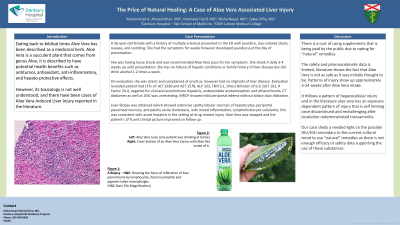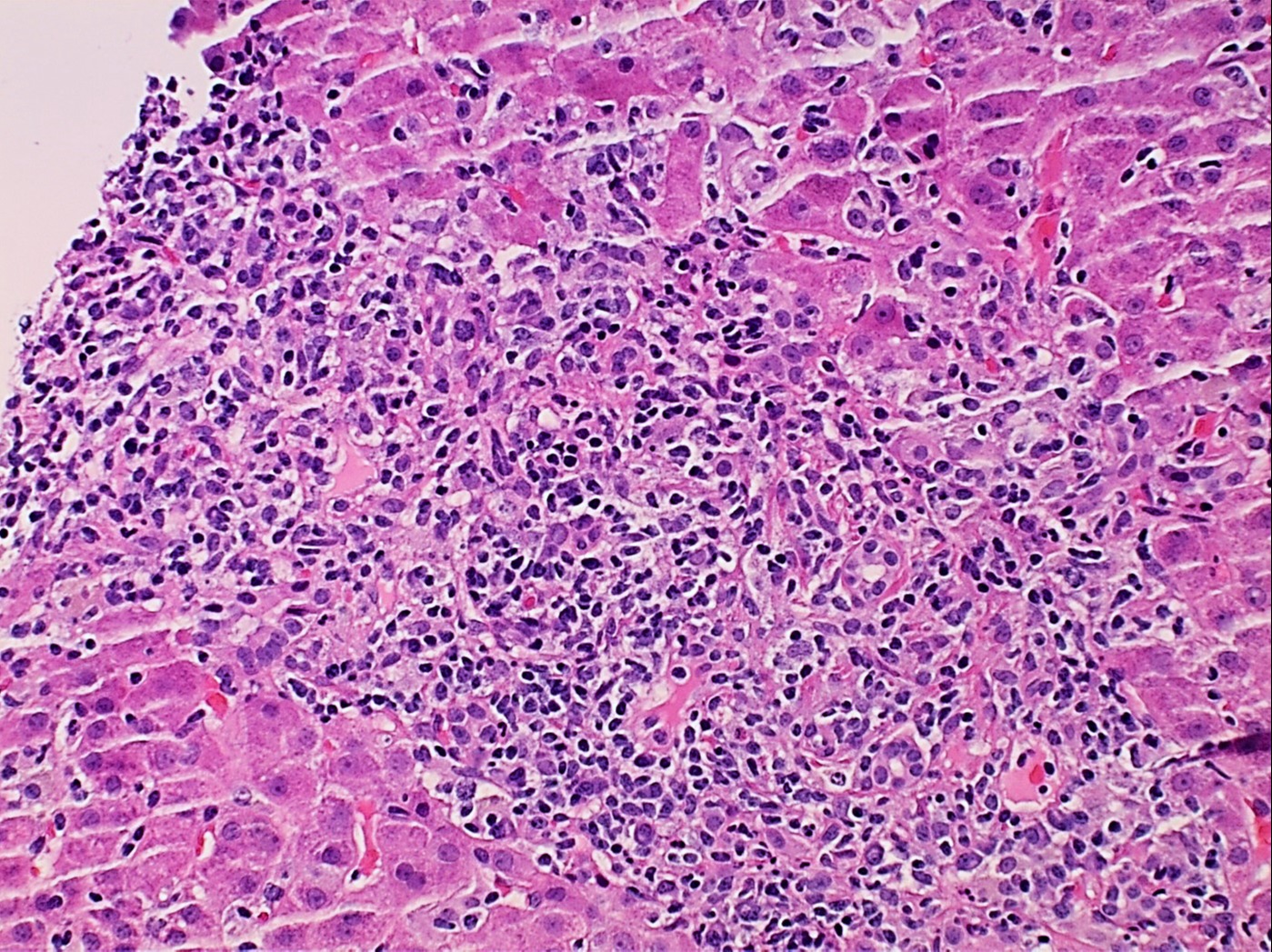Monday Poster Session
Category: Liver
P2549 - The Price of Natural Healing: A Case of Aloe Vera Associated Liver Injury
Monday, October 23, 2023
10:30 AM - 4:15 PM PT
Location: Exhibit Hall

.jpeg.jpg)
Mohammad A. Ahmed-Khan, MD
Danbury Hospital - Yale School of Medicine
Danbury, CT
Presenting Author(s)
Mohammad A. Ahmed-Khan, MD1, Mahnoor Hanif, MD2, Nisha Nepal, MD3, Zakee Jiffry, MD3
1Danbury Hospital - Yale School of Medicine, Danbury, CT; 2CMH Lahore Medical College, Lahore, Punjab, Pakistan; 3Danbury Hospital, Danbury, CT
Introduction: Dating back to biblical times Aloe Vera has been described as a medicinal herb. Aloe Vera is a succulent plant that comes from genus Aloe, it is described to have potential health benefits such as antitumor, antioxidant, anti-inflammatory, and hepato-protective effects. However, its toxicology is not well understood, and there have been cases of Aloe Vera-Induced Liver Injury reported in the literature.
Case Description/Methods: A 56-year-old female with a history of multiple sclerosis presented to the ED with jaundice, clay-colored stools, nausea, and vomiting. She had the symptoms for weeks however developed jaundice just the day of presentation. She was having loose stools and was recommended Aloe Vera juice for her symptoms. She drank it daily 3-4 weeks up until presentation. She has no history of hepatic conditions or family history of liver disease but did drink alcohol 1-2 times a week. On evaluation she was icteric and complained of pruritus, however had no stigmata of liver disease. Evaluation revealed patient had LFTs of: ALT 2630 and AST 1578, ALP 323, TBili 9.1, Direct Bilirubin of 6.9, GGT 161, R Factor 24.4, negative for viral and autoimmune hepatitis, undetectable acetaminophen and ethanol levels, CT Abdomen as well as USG was unrevealing. MRCP showed mild periportal edema without biliary duct dilatation. Liver Biopsy was obtained which showed extensive spotty lobular necrosis of hepatocytes, periportal piecemeal necrosis, and patchy acute cholestasis, with mixed inflammation, lymphohistiocytic cellularity; this was consistent with acute hepatitis in the setting of drug related injury. Aloe Vera was stopped and the patient's LFTs and clinical picture improved on follow up.
Discussion: There is a cost of using supplements that is being paid by the public due to opting for “natural” remedies. The safety and pharmacokinetic data is limited, literature shows the fact that Aloe Vera is not as safe as it was initially thought to be. Patterns of injury show up approximately 3-24 weeks after Aloe Vera intake. It follows a pattern of hepatocellular injury and in the literature aloe vera has an exposure dependent pattern of injury that is self limiting once discontinued and rechallenging after resolution redemonstrated transaminitis. Our case sheds a needed light on the possible DILI/HILI secondary to the current cultural trend to use “natural” remedies as there is not enough efficacy or safety data supporting the use of these substances.

Disclosures:
Mohammad A. Ahmed-Khan, MD1, Mahnoor Hanif, MD2, Nisha Nepal, MD3, Zakee Jiffry, MD3. P2549 - The Price of Natural Healing: A Case of Aloe Vera Associated Liver Injury, ACG 2023 Annual Scientific Meeting Abstracts. Vancouver, BC, Canada: American College of Gastroenterology.
1Danbury Hospital - Yale School of Medicine, Danbury, CT; 2CMH Lahore Medical College, Lahore, Punjab, Pakistan; 3Danbury Hospital, Danbury, CT
Introduction: Dating back to biblical times Aloe Vera has been described as a medicinal herb. Aloe Vera is a succulent plant that comes from genus Aloe, it is described to have potential health benefits such as antitumor, antioxidant, anti-inflammatory, and hepato-protective effects. However, its toxicology is not well understood, and there have been cases of Aloe Vera-Induced Liver Injury reported in the literature.
Case Description/Methods: A 56-year-old female with a history of multiple sclerosis presented to the ED with jaundice, clay-colored stools, nausea, and vomiting. She had the symptoms for weeks however developed jaundice just the day of presentation. She was having loose stools and was recommended Aloe Vera juice for her symptoms. She drank it daily 3-4 weeks up until presentation. She has no history of hepatic conditions or family history of liver disease but did drink alcohol 1-2 times a week. On evaluation she was icteric and complained of pruritus, however had no stigmata of liver disease. Evaluation revealed patient had LFTs of: ALT 2630 and AST 1578, ALP 323, TBili 9.1, Direct Bilirubin of 6.9, GGT 161, R Factor 24.4, negative for viral and autoimmune hepatitis, undetectable acetaminophen and ethanol levels, CT Abdomen as well as USG was unrevealing. MRCP showed mild periportal edema without biliary duct dilatation. Liver Biopsy was obtained which showed extensive spotty lobular necrosis of hepatocytes, periportal piecemeal necrosis, and patchy acute cholestasis, with mixed inflammation, lymphohistiocytic cellularity; this was consistent with acute hepatitis in the setting of drug related injury. Aloe Vera was stopped and the patient's LFTs and clinical picture improved on follow up.
Discussion: There is a cost of using supplements that is being paid by the public due to opting for “natural” remedies. The safety and pharmacokinetic data is limited, literature shows the fact that Aloe Vera is not as safe as it was initially thought to be. Patterns of injury show up approximately 3-24 weeks after Aloe Vera intake. It follows a pattern of hepatocellular injury and in the literature aloe vera has an exposure dependent pattern of injury that is self limiting once discontinued and rechallenging after resolution redemonstrated transaminitis. Our case sheds a needed light on the possible DILI/HILI secondary to the current cultural trend to use “natural” remedies as there is not enough efficacy or safety data supporting the use of these substances.

Figure: Liver Biopsy: Showing the focus of infiltration of liver parenchyma by lymphocytes, focal neutrophils and pigment laden macrophages. (H&E Stain 20x Magnification)
Disclosures:
Mohammad Ahmed-Khan indicated no relevant financial relationships.
Mahnoor Hanif indicated no relevant financial relationships.
Nisha Nepal indicated no relevant financial relationships.
Zakee Jiffry indicated no relevant financial relationships.
Mohammad A. Ahmed-Khan, MD1, Mahnoor Hanif, MD2, Nisha Nepal, MD3, Zakee Jiffry, MD3. P2549 - The Price of Natural Healing: A Case of Aloe Vera Associated Liver Injury, ACG 2023 Annual Scientific Meeting Abstracts. Vancouver, BC, Canada: American College of Gastroenterology.
